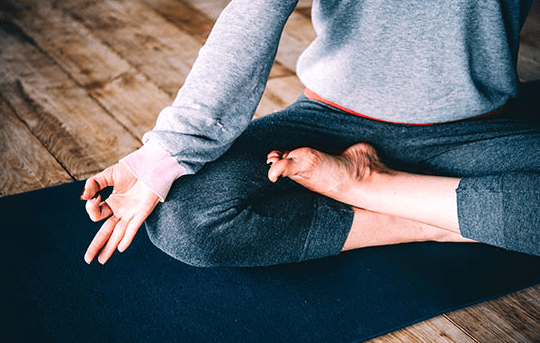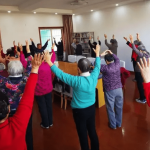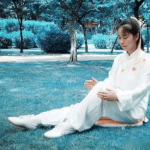For people with insomnia, practicing qigong to fall asleep can be a beneficial approach. Qigong for sleep can compensate for the lack of sleep and gradually lead to a state of calm, helping them to fall asleep and thus eliminating the troubles of insomnia.

Tai Chi:
- Other Names: Tai Yin Divine Sword, Cloud Hand Sword, Fist Embracing Style, etc.
- Characteristics: The movements are gentle, resembling flowing clouds and water, which can make people feel joyful, relax their muscles, and help to fall asleep quickly.
- Benefits: This practice has a good regulatory effect on heart and lung function, enhances breathing depth and frequency, promotes blood circulation, and alleviates anxiety and tension, making people feel at ease.
Ba Duan Jin (Eight Brocades):
- Characteristics: Composed of 8 slow movements, each repeated 4 times.
- Practice Method: Focus attention and adjust breathing while practicing. Take a deep breath and perform the movements while exhaling.
- Benefits: Helps relieve stress and relax the body and mind.
Dao Yin( Mind Leading) Qigong for Sleep
- Content: Includes “breath regulation,” “eye closure,” as well as “Xu” sound exercise and “blowing symbols.”
- Practice Points: Must be combined with breathing.
- Benefits: Regular practice can effectively improve sleep quality and immunity.
- Practice Method:
- Starting Posture: Stand with feet shoulder-width apart, knees slightly bent, and body relaxed. Hands naturally hang at the sides or are placed in front of the lower abdomen.
- Breathing Adjustment: Deep breathing through the nose, filling the lungs, then exhaling slowly. Repeat several times to stabilize and deepen breathing.
- Mind Guidance: Focus on breathing, feeling the airflow through the nose, throat, and lungs. Gradually extend attention to other parts of the body, feeling the weight and support of the body.
- Movement Coordination: Perform slow and fluid movements according to specific Dao Yin techniques, coordinated with breathing to maintain balance and stability.
- Integration of Mind and Breathing: During movements, closely integrate thoughts and breathing. For example, imagine absorbing energy when inhaling and releasing tension when exhaling.
- Ending Posture: Return to the starting position, hands naturally hanging at the sides. Take a few deep breaths and feel the relaxation and comfort of the body.
Seated Strengthening Exercise:
- Method: Sit cross-legged naturally, relax all muscles, head slightly tilted forward, eyes lightly closed, arms naturally hanging down, hands with fingers interlocked placed on the thighs in front of the lower abdomen. Use deep breathing, with the chest and abdomen rising when inhaling, and the chest contracting and the abdomen protruding when exhaling.
- Effect: Helps regulate nervous function, relax the body and mind, and improve sleep quality.
Concentration on Qi Hai or Dan Tian:
- Method: Focus attention on certain body parts such as Qi Hai or Dan Tian to achieve relaxation.
- Benefits: Practicing for at least one hour daily can help improve sleep quality.
Inner Cultivation and Quiet Meditation:
- Characteristics: Combines breath regulation, body adjustment, and mind cultivation to achieve a state of tranquility.
- Suitable for: People with long-term insomnia who wish to improve sleep through internal cultivation.
Small Circulation Sleep Method
Practice Method:
- Lie flat on the bed with your head, torso, and legs naturally aligned.
- Overlap your hands, palms down, and place them on your lower abdomen.
- Deeply inhale through your nose, feeling the air fill your body.
- Slowly exhale.
- With each exhale, guide your mind from the head to the feet, relaxing gradually as if floating in clouds, feeling your body becoming light.
- With each inhale, imagine the energy rising from your lower abdomen to the top of your head.
- With each exhale, imagine the energy descending back to your lower abdomen.
- Repeat the process until you fall asleep.
Benefits: Combining mind and breathing to relax the body, aiding in sleep.
Three-Layer Qigong for Sleep Method
- Practice Method: Similar posture to the Small Circulation Sleep Method, but with hands positioned freely and breathing naturally. Relax the whole body, first guiding the mind from the top of the head down the front of the body to the toes, then from the top of the head down the back of the body to the heels, and finally from the top of the head down the middle of the body to the soles of the feet. Repeat until falling asleep.
- Effect: Relaxing all parts of the body through mind guidance, improving sleep quality.
Acupressure Qiong for Sleep Method:
- Practice Method: Similar posture to the Small Circulation Sleep Method, with hands interlocked and placed on the lower abdomen. First, use the left thumb to press and massage the right hand’s sleep point, counting silently to 120; then switch to the right thumb pressing the left hand’s sleep point, counting silently to 120. Repeat 2-3 times to fall asleep.
- Benefits: Helps to relax the body and mind and promote sleep by massaging specific acupoints like the sleep point.
Hezi Jue and Nine Ghosts Pulling the Saber:
- Characteristics: These two exercises are recommended by the researcher Cui Yongsheng from the General Administration of Sport’s Fitness Qigong Management Center, helping to calm the mind and regulate the body.
- Practice Method:
Hezi Jue:
- Starting Posture: Stand with feet together, step left foot to shoulder-width apart, hands raised to waist level, palms up.
- Action Flow: Slightly draw hands back while squatting, palms slanting down at 45 degrees. Clasp hands, straighten knees, and raise elbows to shoulder height with palms down. Draw hands along the center line while exhaling with a “He” sound, opening palms at navel level. Squat again and repeat.
- Breathing: Use reverse abdominal breathing—the abdomen rises and falls when inhaling.
- Repetitions: Each exhale and sound count as one set; perform 6 sets, 3 times daily.
Nine Ghosts Pulling the Saber:
- Starting Posture: Stand with feet together, step left foot to shoulder-width apart, arms in front of shoulders, palms facing each other.
Action Flow:
- Turn your body 45 degrees to the right.
- Rotate your palms inward, positioning your left hand above your right hand.
- Open your arms in a straight line, with the left hand above the right hand at a 45-degree angle.
- Rotate your waist and swing your arms to the left, moving your left hand behind your waist and your right hand behind your head.
- Turn to the right, open your chest, and pause briefly.
- Rotate to the left, slightly crouch while drawing in your chest and elbows.
- Stand up, rotate to the right, open your arms wide, and open your chest, pausing briefly.
- Repeat the sequence twice.
- Switch the positions of your arms for a side lift.
More about Qigong
What is Zhineng Qigong? What are the Benefits Differences and Features


